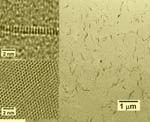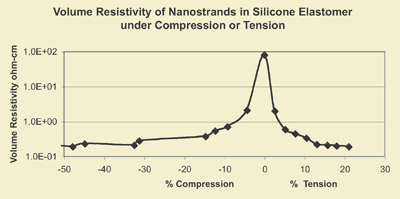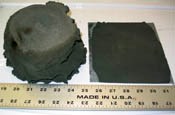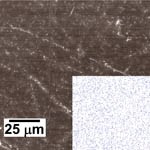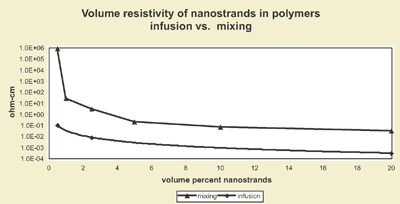From specialty fillers to space elevators
Nanomaterials research and early commercialization set stage for promising future of nanocomposites.
Nanotechnology involves the control and manipulation of materials at the nanoscale — particle sizes from 1 to 1,000 nanometers (nm), where 1 nm equals 1 billionth of a meter. The goal of nanodevelopment in the composites industry is to create new materials that have unprecedented properties due to their small size. Conventional multifunctional materials, such as fiber-reinforced or filled polymers require a trade-off between various mechanical and physical properties, cost and processability. When a key property is emphasized in product development, engineers must typically sacrifice performance in other areas. However, combinations of properties that can be achieved at the nanoscale provide opportunities to circumvent these traditional tradeoffs.
At this stage, many nanomaterials are expensive and not yet well understood, but considerable research, in progress in university, government and private laboratories, promises not only a better understanding of existing materials but new materials as well, together with more efficient, cost-effective processing techniques and methods for using their unique properties in practical applications.
One of the leading groups in nanomaterials research, the Air Force Research Laboratory (AFRL, Wright-Patterson Air Force Base, Ohio), has been working with polymer nanocomposites for several years, working on the theoretical end as well as characterization, fabrication and application. Significant near- to mid-term research for aerospace applications is being conducted, both in its own laboratories and in conjunction with the private sector.
Rich Vaia, AFRL's research leader for polymers, whose group has had a hand in several of the applications noted below, categorizes the technology development and potential opportunities for nanocomposites into three tiers, starting from most elemental uses to the most advanced.
To date, most nano-applications would be classed as Tier 1 developments. Tier 1 nanocomposites can be viewed as an evolution of filled polymer technology, in which nanoelements replace conventional polymer fillers, such as minerals or carbon black. Nano-element-filled polymers can achieve the same properties as their conventionally filled counterparts, using a substantially lower volume fraction of filler. Consequently, these nanofillers offer formulators the opportunity to increase a resin's mechanical properties and improve its processability yet still reduce component weight. In addition to these primary benefits, other novel properties arising from the shape, chemical composition and dispersion of the nanoparticles may contribute to performance by, for example, reducing permeability and flammability, increasing elevated-temperature mechanical properties and/or improving electrical conductivity. Tier 1 composites, however, still rely on conventional glass, aramid, carbon or other fibrous reinforcements for the strength and stiffness required to bear structural loads. A number of nanofillers have been commercialized in composites. More will soon emerge from current development programs, as the following will enumerate.
Vaia defines Tier 2 as the use of nano-elements with the primary aim of adding functionality to traditionally engineered composite designs, to improve, for instance, barrier properties or conductivity in the top layer of a composite or the interlaminar shear between laminate layers. In contrast to Tier 1, where the nanoparticles are dispersed throughout the monolithic polymer as a filler, here the nanoparticles are strategically placed within the macroscale composite design to maximize the benefit of imparting novel functionality. Included in this category are nanoparticles that are being used by researchers as a part of the fiber sizing, to minimize microcracking by improving the gradation between conventional fiber and matrix coefficients of thermal expansion (CTE). While much of this work is being conducted in research laboratories, some is in development for specific near- or mid-term applications (e.g, applications developed by Hybrid Plastics, noted below).
Tier 3 nanocomposites are still very much in the basic research realm right now. These could be defined as "true" nanocomposites, designed and built with precise control of the nanoscale distribution and orientation of the nanoparticles in the matrix, similar to the way fiber weaving or ply orientation is controlled in conventional composite design.
Due to the expense of the nanomaterials and the practical difficulties yet to be surmounted in manufacturing "reinforcement-grade" nanomaterials, Tier 3 nanocomposites are still very much in the basic research realm. By contrast, there has been and continues to be a good deal of product development in Tier 1, and a number of Tier 2 applications are close on their heels.
Tier 1: Nanoclays & CNTs
In the Tier 1 category, nanoclays have been commercialized in the automotive world for several years. Today, they're expanding into aerospace applications. Upcoming applications include sacrificial ablative materials for rocket motor casings, which must have good thermo-mechanical and char characteristics in order to protect the casing from erosion due to the hot gases and aluminum flake used in solid fuels. Existing casing materials are made with EPDM rubber, filled with silica and chopped Kevlar, which is then molded and heat-cured into the rocket. Under a contract with Edwards Air Force Base, a research group headed by Bert Powell at Texas State University at San Marcos (San Marcos, Texas) is investigating water-based polyurethane coatings with clay nanoparticles as a substitute for the silica and Kevlar, which would be easier to process. Preliminary thermo-mechanical testing with polyurethane pellets looked extremely promising, and Powell is now testing three types of water-based urethane coatings, varying the clay loading and thickness of coatings on steel plates, and measuring backside temperature and erosion rates. After achieving a better understanding of the variables, he will move on to comparison testing between the nanofilled polyurethane and EPDM rubber. Testing will be complete in the fall of 2005. An ablative coating soon may be developed that could be applied to a mandrel before part layup and co-molded with the part, or sprayed up on the interior of a demolded part, after cure and mandrel extraction.
Recent work by the AFRL and others has involved using carbon nanotubes (CNTs) in shape memory polymers (SMPs) to make actuators. SMPs can be made from urethanes, styrenes, epoxies or cyanate esters, and are created by tailoring the glass transition and deformation temperatures of a material at the molecular level so that strain energy is retained when the material goes from liquid to solid form. When heat is again applied to the solid, it will relax back to its unstrained shape, and this cycle can be repeated numerous times. Classified by Vaia as somewhere between Tier 1 and Tier 2 materials, CNT-modified SMPs exhibit better performance than unmodified SMPs. The addition of a small amount of CNT can render polymers much more sensitive to light, electric fields, or infrared radiation so that a very small input will effect a large change in shape. Current uses of SMP (e.g., reusable mandrels, medical stents, doll hair), rely on efficient recovery of the composite's original shape when the temperature is increased above a critical thermal transition. There is new interest, however, in using the stored strain energy in an SMP to exert force, enabling mechanical work. This requires a higher rubbery modulus (defined as the modulus between the glass transition and melt point temperature, where the material is softened but not liquid) and an efficient strain-set while maintaining processability, toughness and deformability. To achieve a suitable modulus, however, conventional fillers, such as chopped fibers or glass microspheres, and even some nanosized fillers must be added in quantities as great as 20 to 50 percent, by weight. But use of this much filler degrades other desirable properties. The AFRL has shown that CNT filler added to a thermoplastic urethane elastomer in a dispersion of 5 percent to as little as 1 percent can store and release up to 50 percent more recovery stress than the native resin. Remotely applied energy (e.g., infrared radiation) is absorbed by the nanotubes and the subsequent nonradiative decay raises the internal temperature of the polymer, remotely triggering the release of stored strain energy. In joint research with the AFRL, the University of Dayton Research Institute (Dayton, Ohio) and Miami University (Oxford, Ohio), a 1 percent (by weight) CNT-filled urethane nanocomposite was tested. A 20 mm by 4 mm by 0.4 mm thick (0.79 inches by 0.16 inches by 0.016 inches) sample, which had been deformed 300 percent, was able to apply approximately 19J of energy, sufficient to lift a 60g weight to a height of 30 mm. SMP actuators could eventually be used in robotics, in aircraft or spacecraft to deploy structural framework, or as part of smart systems, which could sense and respond to external stimuli. Current efforts with Cornerstone Research Group Inc. (Dayton, Ohio) and Composite Technology Development Inc. (CTD, Lafayette, Colo.) are expanding these concepts to various aerospace-grade SMP systems.
CNTs come in two varieties. Single-wall nanotubes (SWNTs) are long, thin cylindrical structures, which may or may not have closed ends, composed of carbon atoms arranged in a graphitic lattice structure. Multiwall nanotubes (MWNTs) are composed of nested cylinders or conical sections of carbon in a similar structure, held together by weak intermolecular-level forces. For these and most of its other applications, AFRL is using MWNTs supplied by Applied Sciences Inc. (ASI, Cedarville, Ohio). ASI's MWNTs are several orders of magnitude lower in cost than the single-walled variety (approximately $100/lb compared to $1,000/gram), and have good conductivity. They can be solution blended or added to a solvent medium, and can be functionalized by post process chemical treatments to provide active sites or dangling bonds on the surface of the nanotube for compatibility with a variety of neat resins. With diameters of 2 nm to 250 nm and length-to-diameter aspect ratios greater than 100:1, ASI's MWNTs are easier to process than SWNTs when the goal is good dispersion while maintaining aspect ratio. However, too much mixing can chop up the tubes, reducing aspect ratio, while not enough will cause them to clump or agglomerate, reducing their effect in the resin.
In conjunction with Mound Laser and Photonics Center (Miamisburg, Ohio), the AFRL also is looking at using nanoparticles to generate heat in joining or machining operations. A laser frequency can be selected of the same resonant frequency as the carbon nanotubes, which will cause areas of the material which have concentrations of the CNT to heat up more quickly than the surrounding material. This potentially could be an effective method for thermoplastic welding, composite repair and, eventually, out-of-autoclave curing. A further twist on this is to use iron oxide or other ferromagnetic nanoparticles. When materials which contain these particles are placed in a magnetic field, they will heat up. But when they reach what is called their Curie temperature, the ferromagnetic properties disappear and they cease to heat. This self-regulating property could someday be made into a sort of fail-safe switch, which would be useful for adhesives or repair in the field.
Tier 2: Nanofilament metals & nanostructured chemicals
Three years ago, Metal Matrix Composites Co. (Midway, Utah) began to make and explore Tier 2 opportunities for metal nanofilaments, known as nanostrands. At press time, the company was working on the second enhancement of a U.S. Air Force Phase II SBIR to explore the use of nickel nanofilaments to create conductive paths in polymers, such as adhesives, coatings and elastomers. Lightning-strike materials probably will be one of the earliest applications that will emerge from the SBIR. Currently, expanded metal foil mesh, metal screen or nickel-coated graphite fibers are used for this application, but nickel nanostrand composites may provide better performing, lighter weight materials, either as a veil or as a resin additive.
Metal Matrix Composites founder George Hansen says his firm has studied the use of nickel nanofilaments in combination with nickel-coated carbon fiber and found that having nickel in both the resin and fiber phase of the composite results in a significantly higher specific conductivity (normalized for the increase in weight due to the nickel) than either nickel nanofilament-filled resin and carbon cloth or nickel-coated cloth with unfilled resin. Their combined use allows for the conductivity of the composite to be designed to a targeted conductivity level. In the 'through plane' direction, these conductive composites are up to three orders of magnitude more conductive than standard carbon fiber/epoxy composites.
|
Nickel nanofilaments are very similar to carbon nanofibers and MWNTs but provide the additional electromagnetic, chemical, catalytic, and metallurgical properties of nickel. The nanofilaments can be engineered to diameters ranging anywhere from 50 nm up to 1 µm with aspect ratios generally in the 50:1 to 1000:1 range. A patented vapor decomposition process, carried out at atmospheric pressure and relatively low temperature (generally, the temperature for vapor decomposition is optimal at 175°C/350°F) is used to create an extremely porous (99 percent void) cake or clump of interconnected nanofilaments. The cake is broken up and can be used in either of two ways: dispersed into a resin to form a metal-reinforced polymer or pressed into a shape, such as a thin veil or 3-D structure and then infused with resin, keeping the conductive lattice intact. The infused, interconnected lattice has the effect of increasing the conductivity of a polymer significantly beyond that attained by simply mixing CNT or nickel strands into the polymer. Resistivities of less than 10-2 ohm-cm can be obtained with loadings of as little as 2 percent by volume nanofilaments. By comparison, polymers with resistivities of less than 101 ohm-cm are considered highly conductive.) As a result, the addition of nickel nanofilaments at the rate of only 2.5 percent by resin volume to an otherwise standard carbon-fiber/epoxy prepreg increases its conductivity ten-fold. |
Hansen likens the movement of charge through nickel composites to people being moved through the streets of a city, noting that side streets (like nanofilaments) are necessary to get people onto freeways (nickel coated carbon fiber). A successful transportation system, whether it be for cars or electrons, requires both modes.
The materials can also be used to shield sensitive equipment from electromagnetic radiation (EMI) over a broad range of frequencies. Current EMI shielding materials use silver, copper, nickel or carbon. While each of these materials has its strengths and weaknesses in the marketplace, nanostrands reportedly exhibit a unique combination of aspect ratio, conductivity, magnetism and nanostructure. Independent testing shows that a thin veil of nickel nanofilaments at 20 percent loading offers approximately an 80 dB signal reduction at frequencies from 4 to 18 GHz. Nickel nanofilament composites have the potential to be lighter in weight and much more flexible than current metallic shielding materials, possibly leading to their use for novel stowage applications (in which materials may have to fold and unfold for storage purposes) and conformal coating concepts. While Metal Matrix is currently set up to manufacture only small quantities of nickel nanofilaments, Hansen does not foresee any obstacles to scaling the process up to make larger batches of nickel or other metal nanofilaments. Further, he expects production pricing to be comparable to other nickel commodity powders. Metal Matrix Composites is currently adding capability to make sheets rather than cakes, and expects to have sheets available in the fall of 2005. The sheets will be manufactured in continuous lengths, to desired thickness and density, which then can be either rolled down to veil thicknesses, starting at 0.12 mm (0.005 inch), or broken up and mixed into a wide variety of polymer bases.
|
One of the more distinctive nanomaterials used in Tier 2 applications is poly oligomeric silsesquioxane or POSS, a novel material which was developed by the AFRL. After AFRL tried unsuccessfully for three years to license its POSS technology, Hybrid Plastics (Hattiesburg, Miss.) was spun off in 1998 to develop a pilot manufacturing plant. A POSS molecule possesses a cage-like molecular structure of inorganic silicon and oxygen, with an organic carbon group on each corner. The organic portion of the POSS molecule provides compatibility with existing resins and the inorganic SiO1.5 cage component of the POSS molecule provides thermal and oxidative stability. Hybrid Plastics' CEO Joe Lichtenhan calls POSS a "nanostructured chemical." Because it is a chemical, POSS will dissolve when combined with certain other chemicals, and it has a relatively low (-40°C to 400°C or -40°F to 752°F) melting temperature so that certain variants of it are liquid at room temperature. However, as a nanostructure, its topology (mapped geometrical configuration) and size, within a 1 to 5 nm range, can be precisely controlled. Moreover, POSS is a rigid structure; it will not change shape and cannot migrate or leach out of a polymer mixture. |
The 1 nm to 10 nm length scale is a critical one in polymers because motion of the polymer chains occurs in this range. This motion regulates optical properties, gas and moisture permeability, glass transition and heat deflection temperatures, impact strength and toughness, among others. Dispersed in a resin, POSS molecules can be made to occupy the interstitial spaces between polymer chains, thus restricting the motion of the chains and, therefore, controlling various characteristics of the host polymer.
Hybrid Plastics has already developed more than 155 different POSS variations to be used in thermosets and thermoplastics. Because POSS is manufactured under controlled conditions, trace impurities are negligible, allowing POSS to meet electronics-grade specifications. Many high-performance polymers, such as those used for potting and encapsulating in electronics packaging, are very sensitive to moisture, trace metals and ions. Lichtenhan says that one of the biggest potential commercial markets is hermetic packaging material for electronics applications. POSS can be added to electronics adhesives and packaging materials to "plug" porosity in the polymers, thus reducing the potential for contamination and increasing the manufacturing quality and throughput.
Although Hybrid Plastics has primarily pursued faster-to-market civilian applications rather than military projects, the company is working with the U.S. Navy to qualify POSS materials for use in fire retardant panels for ships and submarines. These panels are currently made in a VARTM process, using balsa cores, brominated vinyl ester and fiberglass, but the Navy is seeking materials with better flame/smoke/toxicity performance. The company developed a POSS molecule with vinyl groups all around the edges of the cage, enabling the material to cure in the same manner as a vinyl ester and be used instead of styrene or vinyl ester. At 1,000 AMU (atomic mass units), POSS weighs an order of magnitude more than most organic monomers and therefore requires much more energy to volatilize and ignite. Also, its carbon content is much lower so there is relatively little fuel for burning. Cone calorimeter testing has shown the POSS material has a peak heat-release rate more than six times slower than brominated vinyl ester, takes 3.5 times longer to ignite and releases very little smoke. This same technology is being studied by the Air Force as an ablative material for rocket motors.
The material is available in liquid and solid form and can be made to specification, either in pure form or concentrated in a specific polymer (master batch). The majority of Hybrid Plastics customers purchase POSS in masterbatch form and then dilute it according to their product needs. According to Lichtenhan, lack of proper dispersion is a primary reason why the properties of nanocomposites often vary widely, and he cautions that while highly automated equipment is not needed to disperse POSS, the issue can be completely avoided by buying material in master batches. POSS is more expensive than nanoclay, costing from $8/lb to $30/lb in master batches, so Lichtenhan seeks applications which require a multifunctional material, for example one that must be antiballistic and have optical clarity (e.g., a car windshield), or the Navy's fire retardant panels which are also more environmentally friendly. POSS also can be combined with nanoparticles to stabilize the nanoparticle dispersion. An example of this is a new version of the company's Nanobond dental adhesive which will feature multiple nanomaterials. POSS also can be used as a catalyst by adding an atom of metal or silane to its cage. Further, it can be used to control the refractive index or radiative and absorptive properties of a material, or in optoelectronics for displays, sensors or computer CPU or memory. Samples of nine different POSS composites are currently orbiting the earth in the International Space Station as part of a 14-month joint NASA/Air Force program seeking materials with improved barrier properties to atomic oxygen.
An as yet unclassifiable material, tier-wise, is new Halloysite. NaturalNano (W. Henrietta, N.Y.) was formed in 2004 to extract, separate, classify and commercialize this new alumina silicate nanotube found in Halloysite clay deposits in Utah. Halloysite nanotubes have an inside diameter of 40 nm to 80 nm and lengths typically ranging from 500 nm to 1.2 µm.
While the tube structures occur naturally (as opposed to CNTs which must be created in a lab or factory setting), they must be separated from the surrounding ore. Like other nanoclays, Halloysite can improve mechanical properties and glass transition temperatures, but due to its tubular structure, it may prove to be especially useful in adding stiffness and strength to polymers or for storing or controlling the release of chemicals or other materials. The nanotube interiors, called lumens, can be loaded with metal and used for radio frequency and EMI shielding. Testing has shown that latex paint with copper-filled Halloysite nanotubes offers a 40 db signal strength reduction across a band from 20 MHz to 20 GHz. Mike Riedlinger, president of NaturalNano, says the company is pursuing its use in biodegradable plastics, such as polylactides, a family of aliphatic polyesters based on lactic acid, with monomers derived from corn, canes, potato starch or other renewable products. These often have low glass transition and melting temperatures and can be relatively weak. Halloysite-modified biodegradable materials eventually may replace non-biodegradable plastics in automotive and aircraft interiors and food packaging. Halloysite nanotubes are now available in small quantities to academic, government, and commercial prospective customers and business partners, but pricing has not yet been fixed.
Tier 3: On the horizon
While much of AFRL's work is classified, Vaia reveals that his team is investigating Tier 3 applications in which electric or magnetic fields are used during polymer processing to control the distribution and orientation of various nanomaterials. For example, montmorillonite (MMT) nanoclays, mined from ore deposits, have varying amounts of antiferro- and ferro-magnetic impurities in their lattice structure.
Vaia has shown that application of a uniform magnetic field to an MMT/epoxy composite at room temperature will cause these different groups to align themselves to the field in perpendicular directions to each other. It then is possible to produce a composite with this orientation by "capturing" this alignment at cure. Since MMT has a very low CTE, one application might be to orient the MMTs perpendicular to a film's surface to reduce the CTE of the material with minimal reduction in optical clarity. Other opportunities could be in the design of synthetic layered MMT composites with unusual magnetic properties.
Just getting started
Tier 1 nanocomposites are well into commercialization and available in products as diverse as automobile fuel lines, baseball bats and bicycle frames. A wave of Tier 2 products that incorporate conductive and magnetic polymers, is on the way. New materials, such as Halloysite nanotubes, are still being discovered and nanosolutions to technical challenges are being explored on all fronts. Perhaps the most far reaching of these — a true Tier 3 application — is a "space elevator" funded, in part, by NASA and envisioned by the LiftPort Group (Bremerton, Wash.). The space elevator is intended to be a superlightweight but super strong 99,779-km/62,000-mile-long carbon nanotube-reinforced composite tether attached to earth at one end and to an orbiting counterweight in space at the other end. LiftPort hopes to launch its first elevator by 2018, using the extremely strong "ribbon" to ferry cargo and passengers into space, without the expense and risk of a conventional rocket launch. (Also see "Hot Nanocomposites Get Hotter," in HPC July 2005, and, in HPC's sister magazine, Composites Technology, "Composites: Past, Present & Future," CT November/December 2001, p. 7.) Before that day arrives, nanocomposites are expected to find their way into myriad other applications, earth-bound, space-bound and points in between.
Related Content
Composite resins price change report
CW’s running summary of resin price change announcements from major material suppliers that serve the composites manufacturing industry.
Read MoreHighly tunable, woven lattice reinforcements target automotive structures
CAMX 2023: Startup Weav3D will be demonstrating its two collaborative automotive demonstrator parts and present two conference papers.
Read MorePlant tour: Albany Engineered Composites, Rochester, N.H., U.S.
Efficient, high-quality, well-controlled composites manufacturing at volume is the mantra for this 3D weaving specialist.
Read More3D-woven composites find success in aerospace, space
CAMX 2024: Bally Ribbon Mills experts are displaying the company’s various joints, thermal protection system (TPS) technologies and other 3D woven composites for mission-critical applications.
Read MoreRead Next
VIDEO: High-volume processing for fiberglass components
Cannon Ergos, a company specializing in high-ton presses and equipment for composites fabrication and plastics processing, displayed automotive and industrial components at CAMX 2024.
Read MoreAll-recycled, needle-punched nonwoven CFRP slashes carbon footprint of Formula 2 seat
Dallara and Tenowo collaborate to produce a race-ready Formula 2 seat using recycled carbon fiber, reducing CO2 emissions by 97.5% compared to virgin materials.
Read MoreDeveloping bonded composite repair for ships, offshore units
Bureau Veritas and industry partners issue guidelines and pave the way for certification via StrengthBond Offshore project.
Read More



